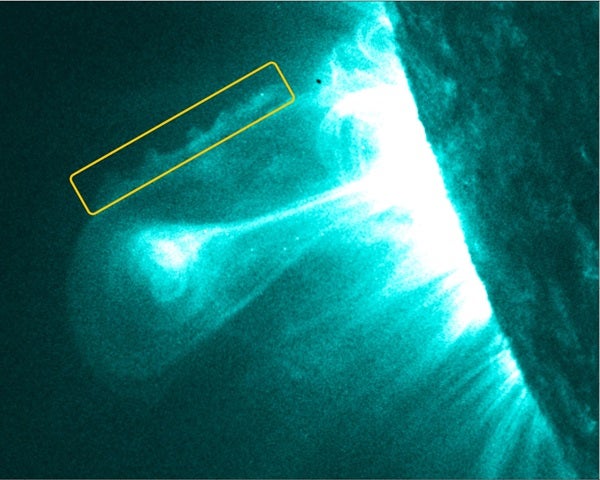These results could greatly assist scientists trying to understand and predict our solar system’s weather.
The researchers, led by the Center for Fusion Space and Astrophysics at the University of Warwick, made their discovery when examining new images of clouds of material exploding from the Sun known as coronal mass ejections (CMEs). These images were provided by the Atmospheric Imaging Assembly (AIA) experiment on NASA’s Solar Dynamics Observatory (SDO). SDO launched last year and provides unprecedented views of the Sun in multiple temperatures.
The new SDO/AIA observations provide images of coronal mass ejections in the extreme ultraviolet at a temperature that was not possible to observe in previous instruments — 11 million kelvin. On examining these images, the researchers spotted a familiar pattern of instability on one flank of an exploding cloud of solar material that closely paralleled instabilities seen in Earth’s clouds and waves on the surfaces of seas.
When observed, these Kelvin-Helmholtz (KH) instabilities appear to roll up into growing whirls at boundaries between things moving at different speeds, i.e., the transition between air and water or cloud. The difference in speeds produces the boundary instabilities.
Similar conditions can occur when one looks at the magnetic environment of the path of these coronal mass ejections as they travel through the solar corona. The difference in speed and energies between the two creates the similar KH instabilities that we can observe in clouds.
While KH instabilities have been predicted or inferred from observations as happening within the solar system’s weather, this is the first time they have been directly observed in the corona. What makes this observation even more interesting is that the instabilities appear to form and build on one flank of the CME. This may explain why CMEs appear to bend and twist as these instabilities build and cause drag on one side of the cloud. This effect will be the next focus for the University of Warwick research team.
“The fact that we now know that these KH instabilities in CMEs are so far only observable in the extreme ultraviolet at a temperature of 11 million kelvin will also help us in modeling CME behavior,” said Claire Foullon from the University of Warwick.
“This new observation may give us a novel insight into why these CMEs appear to both rotate and be deflected away from following a simple straight path from the surface of the Sun. If the instabilities form on just one flank, they may increase drag on one side of the CME, causing it to move slower than the rest of the CME,” she said.
These results could greatly assist scientists trying to understand and predict our solar system’s weather.
The researchers, led by the Center for Fusion Space and Astrophysics at the University of Warwick, made their discovery when examining new images of clouds of material exploding from the Sun known as coronal mass ejections (CMEs). These images were provided by the Atmospheric Imaging Assembly (AIA) experiment on NASA’s Solar Dynamics Observatory (SDO). SDO launched last year and provides unprecedented views of the Sun in multiple temperatures.
The new SDO/AIA observations provide images of coronal mass ejections in the extreme ultraviolet at a temperature that was not possible to observe in previous instruments — 11 million kelvin. On examining these images, the researchers spotted a familiar pattern of instability on one flank of an exploding cloud of solar material that closely paralleled instabilities seen in Earth’s clouds and waves on the surfaces of seas.
When observed, these Kelvin-Helmholtz (KH) instabilities appear to roll up into growing whirls at boundaries between things moving at different speeds, i.e., the transition between air and water or cloud. The difference in speeds produces the boundary instabilities.
Similar conditions can occur when one looks at the magnetic environment of the path of these coronal mass ejections as they travel through the solar corona. The difference in speed and energies between the two creates the similar KH instabilities that we can observe in clouds.
While KH instabilities have been predicted or inferred from observations as happening within the solar system’s weather, this is the first time they have been directly observed in the corona. What makes this observation even more interesting is that the instabilities appear to form and build on one flank of the CME. This may explain why CMEs appear to bend and twist as these instabilities build and cause drag on one side of the cloud. This effect will be the next focus for the University of Warwick research team.
“The fact that we now know that these KH instabilities in CMEs are so far only observable in the extreme ultraviolet at a temperature of 11 million kelvin will also help us in modeling CME behavior,” said Claire Foullon from the University of Warwick.
“This new observation may give us a novel insight into why these CMEs appear to both rotate and be deflected away from following a simple straight path from the surface of the Sun. If the instabilities form on just one flank, they may increase drag on one side of the CME, causing it to move slower than the rest of the CME,” she said.










